Uncompleted after years, Johor Bahru's 'sick' and 'abandoned' property projects leave buyers in limbo
They bought property in Johor Bahru hoping to live or retire comfortably in Malaysia. After paying hefty sums, some are still waiting for their dream homes to be completed.
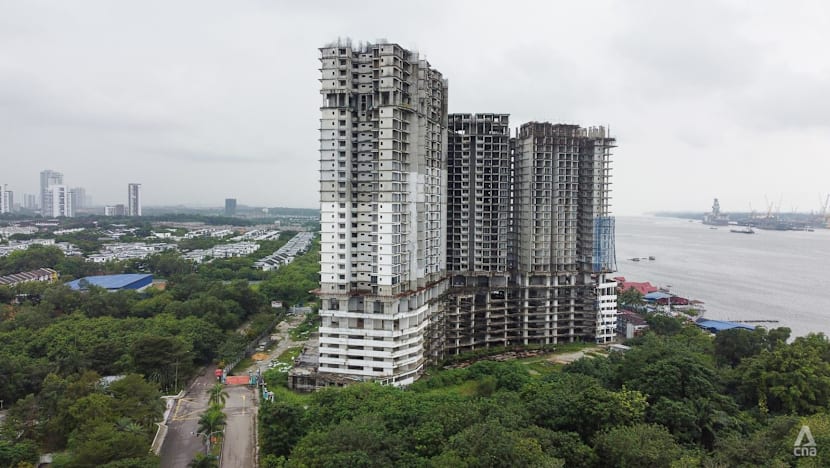
An aerial view of Sovereign Bay, a delayed housing project in Permas Jaya, Johor Bahru, on Sep 9, 2025. (Photo: CNA/Zamzahuri Abas)

This audio is generated by an AI tool.
JOHOR BAHRU: When Singaporean swimming coach Chu Siew Hoe first saw an artist's impression of a luxurious waterfront condominium in Johor Bahru 10 years ago, he imagined a peaceful retirement in a spacious apartment overlooking the Straits of Johor.
To fund the RM1 million (US$238,100) purchase of a dual-key unit at Sovereign Bay in full, Chu, now 65, refinanced his Sengkang executive condominium, borrowing S$300,000 from the bank.
A decade on, Sovereign Bay, located in Permas Jaya on the coast, remains an unfinished mass of concrete.
The project is developed by UE E&C Sanjia, a joint venture between UE E&C from Singapore and China's Sichuan Sanjia Real Estate Group.
It was slated for completion in October 2019 but is currently listed as an “abandoned” project by Malaysia’s Ministry of Housing and Local Government. This refers to a project that is not completed by the delivery date stated in the sale and purchase agreement and for which there is no significant activity at the construction site for six consecutive months.
Meanwhile, Chu is making monthly mortgage repayments of around S$2,000 by juggling his swimming school and part-time private-hire driving.
There is no certainty when — or if — he will ever hold the keys to his Johor Bahru home.
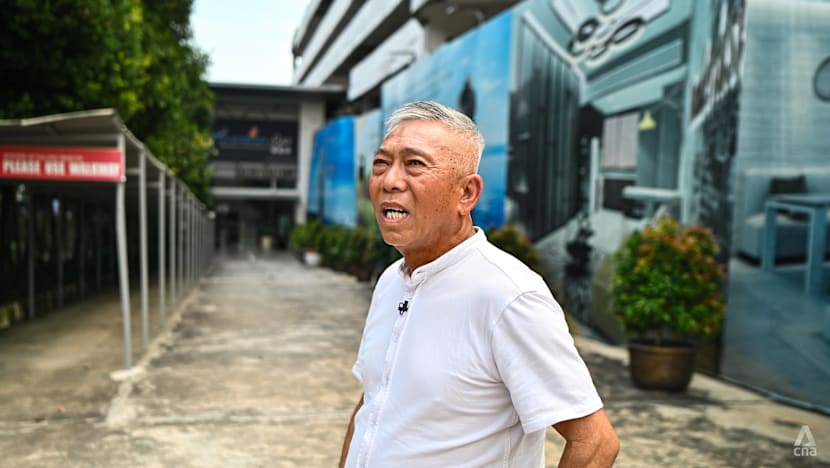
“I am very worried because I still need to pay the interest to the bank,” Chu said, his voice weary. “No choice. I need to struggle.”
Chu isn’t the only one in this predicament.
Johor Bahru’s property market has long drawn Singaporeans seeking relative affordability and proximity. Its appeal has been further fuelled by major projects such as the upcoming RTS Link and the Johor-Singapore Special Economic Zone.
But the city is also home to a significant share of Malaysia’s troubled developments.
Government figures show Johor Bahru has 12 condominium projects listed as “sick” — a designation for developments delayed by more than 30 per cent compared to the scheduled progress, or if the period stipulated in the sale and purchase agreement has expired.
Outside of the dense Klang Valley in Selangor, Johor Bahru is among the cities in Malaysia with the highest number of sick projects, alongside Seremban and Kuantan.
Johor is among the states with the highest number of unfinished abandoned projects, behind only Selangor and Terengganu.
With interest in Johor Bahru properties continuing to grow, property experts and lawyers said prospective buyers must learn from the negative experiences of some buyers and be more discerning in picking projects to invest in.
Some lawyers and impacted buyers also suggested that the Malaysian government could do more to enforce property laws and impose stiffer sanctions against developers who miss construction deadlines.
Besides Sovereign Bay, other projects in Johor Bahru that have missed construction deadlines include The Peak by Malaysian developer Gabungan AQRS, which was due to be completed by 2016, and Jade Palace, which was initially launched by Chinese developer Greenland Group and was due to be completed by 2020.
The Peak is located in Tebrau, while Jade Palace is at Danga Bay.
All three were to be serviced apartments which, in Malaysia, refer to upscale condominium units built on land for commercial use. They may be owned by individual buyers for their own occupation, or to rent out.
Joining them on the government’s list of sick or abandoned projects are the condominium One Danga, as well as landed property developments Glenmarie Johor, Danga Sutera and JLG Land’s flexi-home at Bandar Dato Onn.
However, unlike the others, Sovereign Bay, The Peak and Jade Palace are closer to the city centre and have therefore drawn greater interest from foreign buyers.
All three projects had marketing campaigns in Singapore to entice buyers from across the Causeway, and a third of Sovereign Bay buyers were reportedly Singaporeans.
The troubled developments have brought disappointment and financial stress for their buyers, some of whom have stopped payments altogether and are seeking compensation from the developers in court.
Singaporean Kenneth Tan signed an agreement to purchase a high-floor unit at The Peak in 2013 for around RM1.7 million.
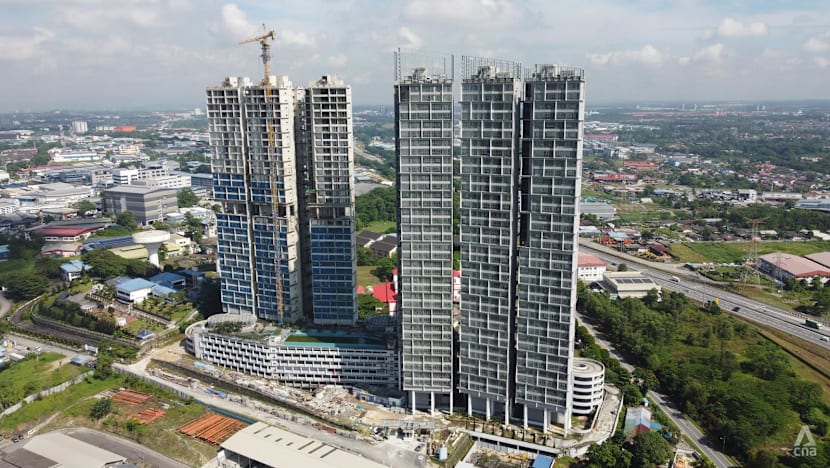
Tan, who lives in a Housing and Development Board flat in Singapore, envisioned living in the 2,000 sq ft apartment with a balcony overlooking the city.
Over the next six years, he paid up the booking fee and “hundreds of thousands” of dollars.
In 2022, he stopped making payments as the developer was not communicative, he said. The 45-year-old is now “resigned to losing six figures” in Singapore dollars, and is prepared to relinquish his ownership to put the whole matter behind him.
“When we made the purchase, the (conversion rate) between the Singapore dollar and the Malaysian ringgit was roughly 2.1:1, so given that it is now 3.2:1, the losses we made are bigger in that sense,” said Tan.
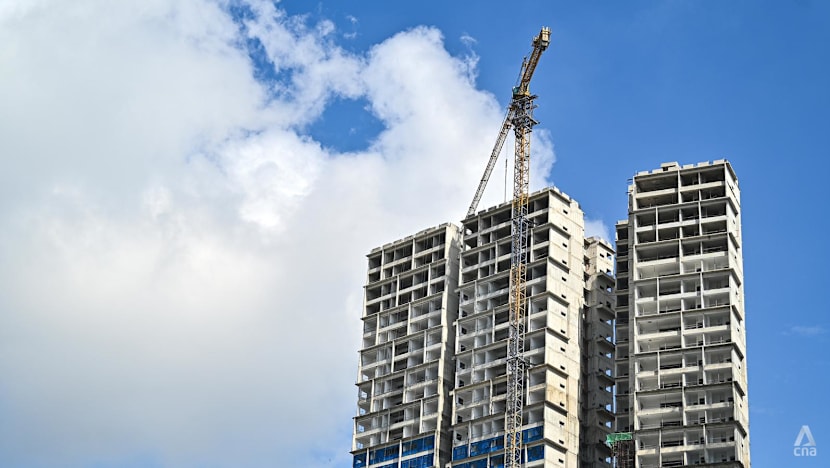
On a recent visit to the site, CNA saw that one of The Peak’s two towers stood incomplete, while the other’s structure appeared hollow. There were bare concrete walls and stacks of air-conditioning units stored on the lower floors.
Its sales gallery in Taman Molek still displayed the project’s original signboard, but the space itself was under construction.
An Australian couple, who asked to be identified only as WM and KR, told CNA they purchased two apartments at The Peak in 2012, paying about A$180,000 in instalments.
When construction slowed and the developer began re-marketing the remaining units at 30 per cent less than what they had paid, the couple stopped making payments.
“At this stage, there is no honest completion date after 13 years,” they wrote in an email.
“We had planned to retire in Johor Bahru under the Malaysia My Second Home programme. The marketing was convincing, and the timeline seemed to fit our plans. Now we have abandoned that dream and it seems we have lost everything we invested,” they added.
Issues may also arise after moving in
At Country Garden Danga Bay, one of Johor Bahru’s largest seafront estates, Plot 4 (King’s Bay and Laurel Bay) was originally meant to house four towers. Only three were built, leaving an unfinished foundation that has become a blight for existing residents.
Maurizio Altieri, a retired engineer who has lived there for seven years, said the incomplete structure has caused water to pool in a large pit, creating a breeding ground for mosquitoes.
“We have been asking for at least three years to fix this,” he said. “As a civil engineer, I even proposed a simple and cheap solution. Nobody listens. Nobody takes care of it.”
Altieri and other residents have also reported leaks, cracks, rust, and mould on building facades, but claim their complaints to the joint management body have gone unanswered.
The issue came to the fore during the residents’ recent Annual General Meeting in August, which CNA attended.
Things got heated between the residents and representatives of the condominium’s management, leading to the police being summoned. In the end, around 40 residents submitted a petition calling for a change to the joint management body.
In response to queries from CNA, Country Garden Danga Bay said the project has "advanced steadily in line with its master plan".
To date, more than 7,500 residential units have been successfully delivered and accommodate over 20,000 residents, it said. Key facilities including shopping malls, supermarkets, and community service centres are "fully operational and continuously enhanced".
"Our development strategy is guided by comprehensive market analysis and a disciplined, phased approach. The next phase of construction will be launched at an optimal time, ensuring alignment with actual market conditions and maximising long-term value for stakeholders," it said.
"We remain confident in the growth trajectory of Johor Bahru and the Danga Bay Project. With a long-term commitment and a responsible development philosophy, Country Garden will continue to enhance the community’s value, strengthen its market position, and create sustainable returns for all stakeholders," it added.
Danga Jed Development, a unit of Greenland group, is the registered developer of the Jade Palace project according to the Ministry of Housing and Local Government portal.
Danga Jed Development told CNA that "the project has made substantial progress and is now approaching completion by stage".
Deputy Minister of Housing and Local Government Aiman Athirah Sabu was quoted in Dec 2024 as saying that she hoped that the project can be completed within “the set timeline, by the third quarter of 2027”.
In its response to CNA, Danga Jed Development did not say whether the project would be completed by this timeline.
It added that it has reached out to all buyers of the Jade Palace project through its lawyers.
"Our company has duly updated our contact information with the Ministry of Housing and Local Government and has issued formal notifications through our appointed solicitors to all registered purchasers, inviting them to communicate regarding project updates," it told CNA.
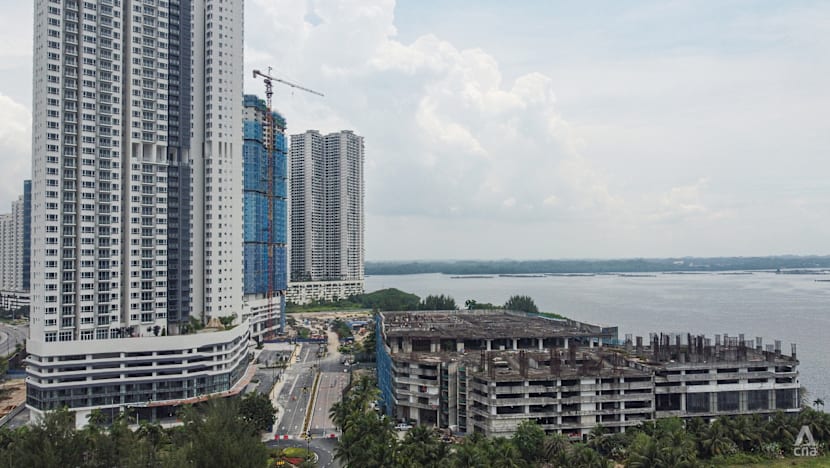
Responding on Oct 6 to CNA's queries, The Peak's developer Gabungan AQRS said it acknowledges and sincerely regrets the project delays that led to it being classified as a "sick" project.
"AQRS recognises the real challenges faced by purchasers who have been waiting longer than anticipated for their homes at The Peak, including the financial sacrifices many have had to make while awaiting delivery," the developer said.
Gabungan AQRS said as of October, 89 per cent of the works have been completed and both towers "remain on track for practical completion in the second quarter of 2026".
It added that delays at The Peak did not arise in isolation and the "entire Malaysian property sector faced unprecedented headwinds" including COVID-19 pandemic restrictions.
The aftermath of COVID-19 halted construction works nationwide, creating prolonged shortages of both labour and materials, it said. "These disruptions had cascading effects across the property development sector and intensified the challenges faced by projects already underway."
The company took measures to stabilise the project that included injecting capital, restructuring financing, and engaging closely with contractors and regulators to ensure momentum was maintained, it said.
"Our commitment remains unwavering: to deliver the homes our purchasers rightfully expect, and to do so responsibly and transparently," said Gabungan AQRS.
It added that the project's sales gallery located in Taman Molek is currently undergoing renovation and is scheduled to reopen by end-October 2025.
"This will serve as a hub for transparent communication, updates, and engagement with buyers as we move into the final stages of delivery," said Gabungan AQRS.
CNA has approached the developer for Sovereign Bay, UE E&C Sanjia, for comment on when the project will be completed and if there will be compensation for buyers who have made a significant portion of the payments.
BETTER ENFORCEMENT NEEDED: LAWYERS
Lawyers said the abandoned and sick projects are likely due to developers facing cashflow issues that were exacerbated by the COVID-19 pandemic.
A significant number of developments in Johor Bahru over the last decade have been by Chinese companies, they noted. During the COVID-19 pandemic, the Chinese government rolled out policies to rein in the massive debt accrued by the property industry, tightening conditions for access to credit.
Unable to borrow and struggling to sell apartments, these developers faced a severe cash crunch, resulting in unfinished homes and unpaid suppliers and creditors.
The companies and their joint venture or subsidiaries’ projects in the region were impacted.
Property lawyer Chee Hui Bing of Malaysian firm Chris & Partners told CNA the issue is particularly pertinent to Johor, given the state’s high concentration of Chinese property investment over the last decade.
“From what I’m aware, it is still China’s policy to restrain their own developers from (investing) overseas,” said Chee.
He was referring to China government's "three red lines policy" implemented in 2020, which tightened conditions for developers to access credit.
In 2017, Beijing also tightened restrictions on capital outflows to support the ailing yuan currency, and this reportedly impacted property investment by Chinese companies.
Analysts have previously said that tremors within China's property sector could have potential spillover effect in the region.
“So in terms of what advice I can give to Singaporeans or locals keen on buying houses in Johor, if, let’s say they encounter housing developments/mega projects by China-linked companies, they should be (wary),” said Chee.
He added that Malaysian authorities can do more to enforce the country’s laws and clamp down on errant developers who miss construction deadlines.

According to the Housing Development (Control and Licensing) Regulations in 1989, there are mandatory statutory agreements with clauses ensuring the timely delivery of property as well as requirements for the developer to place a deposit with the government equivalent to 3 per cent of the estimated construction costs.
Chee said that it seems clear some developers have flouted construction deadlines, adding that there are no public records of any of them facing repercussions for doing so or making any reimbursement and compensation to buyers.
"The best thing the Malaysia government can do is to ensure that developers (who do not meet construction deadlines) are punished ... (and) buyers are reimbursed," he said.
In his view, there is also a disconnect between the state’s authority and the federal government’s authority over property projects. It is state governments that typically issue licences for construction, but the federal government that enforces whether developers commit to the construction schedule, he said.
"Malaysia is perhaps too big … I hope that the Malaysia Madani government can go after the projects which are abandoned by huge companies because this is key,” he said, suggesting Johor could consider some policies that Singapore has put in place.
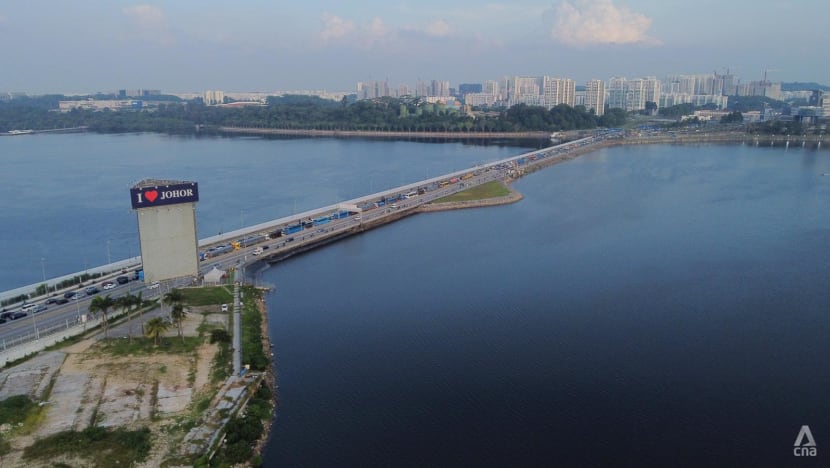
Tris Xavier, head of the integrated property practice group at Singapore legal firm Yuen Law, said developers in Singapore are required to have a minimum paid up capital depending on the number of units they have, as well as a minimum bankers’ guarantee and proof of a track record.
“To be clear, Singapore has had experiences with developers going bust,” said Xavier, citing how in 2019, developers of the Laurel Tree and Sycamore Tree projects became insolvent, leaving buyers hanging.
Laurel Tree was a condominium project at Hillview Terrace by developer Lerida, while Sycamore Tree was a block in Joo Chiat with residential and commercial units by Astoria Development.
“It’s worthwhile to highlight that all purchases carry risk,” said Xavier. “However, Singapore has tried to mitigate or reduce this risk as much as possible. Other countries will have different regulations, and buyers are encouraged strongly to seek advice from lawyers and/or experts from the country they intend to buy property in.”
Johor-based analyst Samuel Tan, chief executive of boutique firm Olive Tree Property Consultants, said the Johor state government has established a special task force to resolve sick projects and, as of May 2024, nine projects had been identified for redevelopment.
The federal government also has a taskforce for sick and abandoned private developments (TFST) led by deputy minister of housing and local government Aiman Athirah Sabu.
In a recent press release, TFST said that between Jun 30 and Aug 31, it had reduced the number of sick projects in the country from 360 to 345, and the number of abandoned projects from 109 to 108.
Since the taskforce was formed in 2023, 1,260 private housing projects with a combined gross development value of RM121.44 billion have been successfully redeveloped, it said.
The ministry said this was achieved by more effective monitoring, better collaboration with different stakeholders, and intervention when construction timelines are not met.
Tan said more can be done, particularly in Johor.
“Ensuring housing projects are completed on time is extremely critical for Johor. It protects homebuyers who are paying loans, sustains confidence among local and foreign investors and reinforces Johor’s reputation as a reliable property market, especially with the RTS and SEZ driving demand,” he said.

HOW CAN BUYERS PROTECT THEMSELVES?
Prospective buyers should check developers’ track record and avoid those in poor financial health, Tan said.
They could use the Malaysian government’s housing portal TEDUH, which lists developers’ past projects and the status of upcoming projects, Chee said.
Buyers are also encouraged to review the sale and purchase agreement carefully to understand delivery timelines and compensation terms for delays.
They should check the bank that is financing the project, as major banks “usually indicate higher due diligence and credibility”, Tan said.
They could avoid buying newly launched projects and opt for projects that are already completed or resale units, Chee said.
“Why should buyers consider something that is a speculative risk and has a lot of uncertainties? Better you pick a ready-made unit in a developed township,” he said.
As for buyers of projects where the developer has failed to deliver according to the sale and purchase agreement, Tan said they could file a claim with a small claims tribunal if they are seeking compensation of up to RM50,000.
For larger amounts, buyers may consider a civil suit individually or a class action with fellow buyers.
Class action suits are trickier because there are more moving parts and developers may choose to settle with some buyers and not others, Chee cautioned.
Property buyer Kenneth Tan said he is keen to pursue an individual civil suit against the developer of The Peak in hopes of recouping some losses.
“I think there is some precedent as some of the other owners have managed to recoup some money. But still, factoring in legal costs, I still expect to be in the red overall," he said.
Sovereign Bay buyer Chu is opting to wait for his apartment to be constructed. Some employees of the developer have informed him that the project would be ready by 2027, he said.
“Some people accuse me of being (naive) for thinking that I will finally move in,” said Chu.
“But I’m confident that one day I will collect my keys ... and be happy that the wait (was) worthwhile.”
Editor’s note: This article has been updated to reflect that Danga Jed Development, a unit of Greenland group, is the developer of the Jade Palace project following clarifications by the company. An earlier version of the article also carried quotes from a property buyer but these have been removed as the developer said it did not have records of the buyer.




















